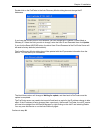
Chapter 2: Installation
Multi-Tech Systems, Inc. FaxFinder Admin User Guide 33
At this point, the FaxFinder ‘home’ page is displayed. Click on Phone Book to see the updated
values.
The next step (B1) will depend on the routing mode (automated or manual) used.
B1. “Pots Line n” Rows: Automated Routing Mode only
In the “Pots Line n” rows of the Phone Book screen (where n is 1 for the FF120, 1-2 for the FF220,
1-4 for the FF420, and 1-8 for the FF820), enter the email address of the person whom you want to
receive all inbound faxes sent to unassigned PBX phone numbers. (For example, suppose extra PBX
extensions were allocated to incoming faxes but were not specifically assigned to any individual
employee. Faxes sent to those PBX extensions would go to the email address of the FaxFinder
modem on which it was received, which would correspond to one of the “Pots Line
n” rows of the
Phone Book.) In general, it would also be possible to direct unassigned faxes to a different email
address for each FaxFinder modem. This is a matter of convenience or preference.
B1. “Pots Line n” Rows: Manual Routing Mode only
In the “Pots Line n” rows of the Phone Book screen, enter the email address of the person(s) whom
you want to receive all faxes sent to each FaxFinder modem. This party becomes essentially the ‘fax
attendant’ for that particular FaxFinder modem. This is the person who forwards received faxes to
their intended recipients, typically by forwarding the email to which the fax message is attached.
A natural approach to fax attendant assignments would be to have one attendant for each department
of a company. For example, Art Jones might be the fax attendant for the accounting department, Sue
Thompson the attendant for the sales department, Dee Brooks for the customer service department,
and Ray Dodd for the repair department. If an FF420 FaxFinder were used, each of these fax
attendants could be assigned one of its modems.


















